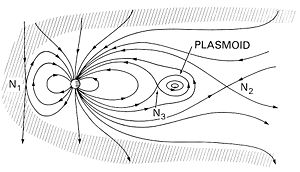
Back بلازمويد Arabic Plazmoid Czech Plasmoide Spanish Plasmoïde French Plazmoid Hungarian Plazmoid Polish Plasmoide Portuguese Плазмоид Russian Плазмоїд Ukrainian 電漿粒團 Chinese

A plasmoid is a coherent structure of plasma and magnetic fields. Plasmoids have been proposed to explain natural phenomena such as ball lightning,[1][2] magnetic bubbles in the magnetosphere,[3] and objects in cometary tails,[4] in the solar wind,[5][6] in the solar atmosphere,[7] and in the heliospheric current sheet. Plasmoids produced in the laboratory include field-reversed configurations, spheromaks, and in dense plasma focuses.
The word plasmoid was coined in 1956 by Winston H. Bostick (1916-1991) to mean a "plasma-magnetic entity":[8]
The plasma is emitted not as an amorphous blob, but in the form of a torus. We shall take the liberty of calling this toroidal structure a plasmoid, a word which means plasma-magnetic entity. The word plasmoid will be employed as a generic term for all plasma-magnetic entities.
- ^ Silberg, Paul A. (November 1962). "Ball lightning and plasmoids". Journal of Geophysical Research. 67 (12): 4941–4942. Bibcode:1962JGR....67.4941S. doi:10.1029/JZ067i012p04941.
- ^ Friday, DM; Broughton, PB; Lee, TA; Schutz, GA; Betz, JN; Lindsay, CM (3 October 2013). "Further insight into the nature of ball-lightning-like atmospheric pressure plasmoids". The Journal of Physical Chemistry A. 117 (39): 9931–40. Bibcode:2013JPCA..117.9931F. doi:10.1021/jp400001y. PMID 23767686.
- ^ Hones, E. W., Jr., "The magnetotail - Its generation and dissipation", (1976) Physics of solar planetary environments; Proceedings of the International Symposium on Solar-Terrestrial Physics, Boulder, Colo., June 7–18, 1976. Volume 2.
- ^ Roosen, R. G.; Brandt, J. C., "Possible Detection of Colliding Plasmoids in the Tail of Comet Kohoutek" (1976), Study of Comets, Proceedings of IAU Colloq. 25, held in Greenbelt, MD, 28 October - 1 November 1974. Edited by B. D. Donn, M. Mumma, W. Jackson, M. A'Hearn, and R. Harrington. National Aeronautics and Space Administration SP 393, 1976., p.378
- ^ Lemaire, J.; Roth, M. (1981). "Differences between solar wind plasmoids and ideal magnetohydrodynamic filaments". Planetary and Space Science. 29 (8): 843–849. Bibcode:1981P&SS...29..843L. doi:10.1016/0032-0633(81)90075-1.
- ^ Wang, S.; Lee, L. C.; Wei, C. Q.; Akasofu, S.-I., A mechanism for the formation of plasmoids and kink waves in the heliospheric current sheet (1988) Solar Physics (ISSN 0038-0938), vol. 117, no. 1, 1988, p. 157-169.
- ^ Cargill, P. J.; Pneuman, G. W., "The energy balance of plasmoids in the solar atmosphere" (1986), Astrophysical Journal, Part 1 (ISSN 0004-637X), vol. 307, Aug. 15, 1986, p. 820-825.
- ^ Bostick, Winston H (1956). "Experimental Study of Ionized Matter Projected across a Magnetic Field". Physical Review. 104 (2): 292–299. Bibcode:1956PhRv..104..292B. doi:10.1103/physrev.104.292.
© MMXXIII Rich X Search. We shall prevail. All rights reserved. Rich X Search